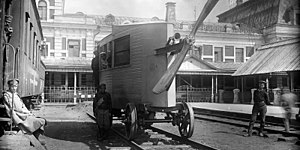Aerowagon
This article needs additional citations for verification. (July 2012) |
| Аэроваго́н | |
|---|---|
 Abakovsky's Aerowagon | |
| Manufacturer | Valerian Ivanovich Abakovsky |
| Built at | Russia |
| Constructed | 1917 |
| Scrapped | 1921 |
| Number built | 1 |
| Specifications | |
| Prime mover(s) | Aircraft engine |
The Aerowagon or Aeromotowagon (Russian: Аэроваго́н, аэродрези́на) was an experimental high-speed railcar fitted with an aircraft engine and propeller traction invented by Valerian Abakovsky, a Soviet engineer from Latvia. It produced speeds of up to 140 kilometres per hour (87 miles per hour). The Aerowagon was originally intended to carry Soviet officials.
Crash incident[]
On 24 July 1921, a group of delegates to the First Congress of the Profintern,[1] led by Fyodor Sergeyev, took the Aerowagon from Moscow to the Tula collieries to test it. Abakovsky was also on board. Although they successfully arrived in Tula, on the return route to Moscow the Aerowagon derailed at high speed near Serpukhov,[1] killing six of the 22 people on board. A seventh man later died of his injuries.[2]
Deaths[]
The following people died as a result of the accident:
- [ru], Bulgarian delegate
- , Australian delegate
- Oskar Helbrich, German delegate
- John William Hewlett, British delegate
- Fyodor Sergeyev (known as "Comrade Artyom")
- Otto Strupat (born 1893), German delegate
- Valerian Abakovsky himself, at the age of 25.

The seven men killed at the time of the crash lay in state at the House of the Unions, after which they were buried in the Kremlin Wall Necropolis.[2][3] Sergeyev is buried in Mass Grave No. 12, Konstantinov, Abakovsky and Freeman are buried in Mass Grave No. 13, while Strupat, Helbrich and Hewlett are buried in Mass Grave No. 14.
Legacy[]

The Aerowagon was a precursor to the German Schienenzeppelin railcar, the American M-497 Black Beetle railcar and the Soviet turbojet train, all three of them being experimental vehicles featuring the combination of railcar and aircraft engine.
References[]
- ^ a b The Communist International, organ of the Executive Committee of the Communist International, no.19, [1921]
- ^ a b Letters from Tom Mann to Elsie Mann, Moscow, 26 and 30 July 1921; archives of Tom Mann, Modern Records Centre, University of Warwick, document references: MSS.334/3/6/5-6.
- ^ "КРАСНАЯ ПЛОЩАДЬ - это... Что такое КРАСНАЯ ПЛОЩАДЬ?". academic.ru. Retrieved 29 November 2017.
Bibliography[]
- Alexey Abramov / Алексей Абрамов, By the Kremlin Wall / У кремлёвской стены, Moscow / Москва́, Politizdat / Политиздат, 1978, pp./стр. 399 (in Russian)
- Experimental locomotives
- Latvian inventions
- Railcars of Russia
- Soviet inventions
- Scrapped locomotives